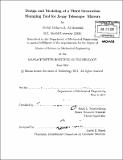| dc.contributor.advisor | Mark L. Schattenburg. | en_US |
| dc.contributor.author | Al Husseini, Abdul Mohsen Z. (Abdul Mohsen Zuheir) | en_US |
| dc.contributor.other | Massachusetts Institute of Technology. Dept. of Mechanical Engineering. | en_US |
| dc.date.accessioned | 2011-12-09T21:31:36Z | |
| dc.date.available | 2011-12-09T21:31:36Z | |
| dc.date.copyright | 2011 | en_US |
| dc.date.issued | 2011 | en_US |
| dc.identifier.uri | http://hdl.handle.net/1721.1/67607 | |
| dc.description | Thesis (S.M.)--Massachusetts Institute of Technology, Dept. of Mechanical Engineering, 2011. | en_US |
| dc.description | Cataloged from PDF version of thesis. | en_US |
| dc.description | Includes bibliographical references (p. 141-144). | en_US |
| dc.description.abstract | Glass sheets with high surface quality and angular resolution of 5 arcsec are in demand for the International X-Ray Observatory. Several glass flattening techniques are presented in this thesis, including a method of thermally shaping individual sheets of glass using porous mandrels as air bearings developed at the Space Nanotechnology Lab. This method, a second generation slumping tool, eliminates the problems of sticking and dust particle-induced distortion that plague traditional slumping methods. A detailed mathematical model of the slumping process is developed, allowing prediction of final glass shape based on process parameters that include air supply pressure, imperfections on the mandrel surface, glass total thickness variations and gravity vector orientation. Simulations were conducted for a variety of scenarios to study the impact of apparatus tilt and pressure asymmetries on glass shape. Experiments to verify model findings are conducted under closed-loop control of pressure and apparatus tilt. Little improvement in repeatability is seen, suggesting that the error is due to unmodeled forces such as contact forces from the glass holding technique. Finally, the design process and fabrication of a third generation slumping tool is presented. In addition to scaling the design to accommodate larger flats, slumps are done horizontally to float the glass and minimize contact during the process. New capabilities of the tool also include active gap measurement and control, as well as plenum air temperature monitoring. | en_US |
| dc.description.statementofresponsibility | by Abdul Mohsen Z. Al Husseini. | en_US |
| dc.format.extent | 144 p. | en_US |
| dc.language.iso | eng | en_US |
| dc.publisher | Massachusetts Institute of Technology | en_US |
| dc.rights | M.I.T. theses are protected by
copyright. They may be viewed from this source for any purpose, but
reproduction or distribution in any format is prohibited without written
permission. See provided URL for inquiries about permission. | en_US |
| dc.rights.uri | http://dspace.mit.edu/handle/1721.1/7582 | en_US |
| dc.subject | Mechanical Engineering. | en_US |
| dc.title | Design and modeling of a third generation slumping tool for X-ray telescope mirrors/ | en_US |
| dc.title.alternative | X-ray telescope mirrors | en_US |
| dc.type | Thesis | en_US |
| dc.description.degree | S.M. | en_US |
| dc.contributor.department | Massachusetts Institute of Technology. Department of Mechanical Engineering | |
| dc.identifier.oclc | 765335408 | en_US |
